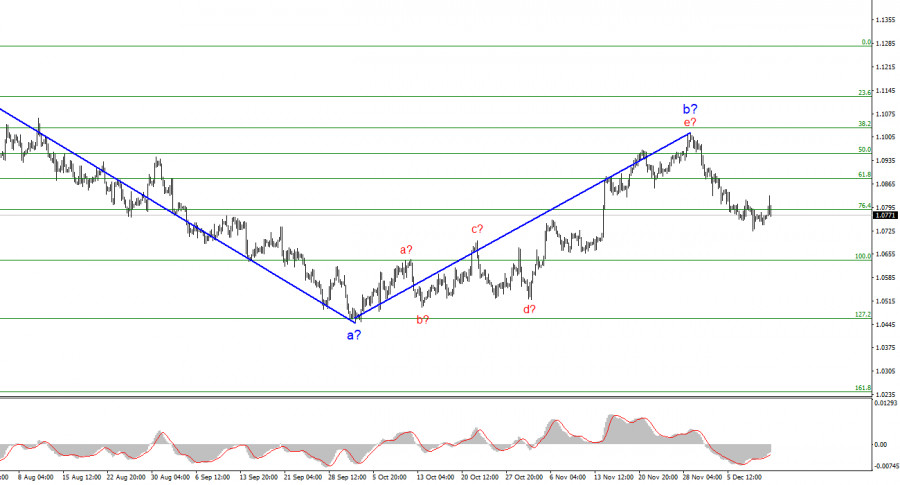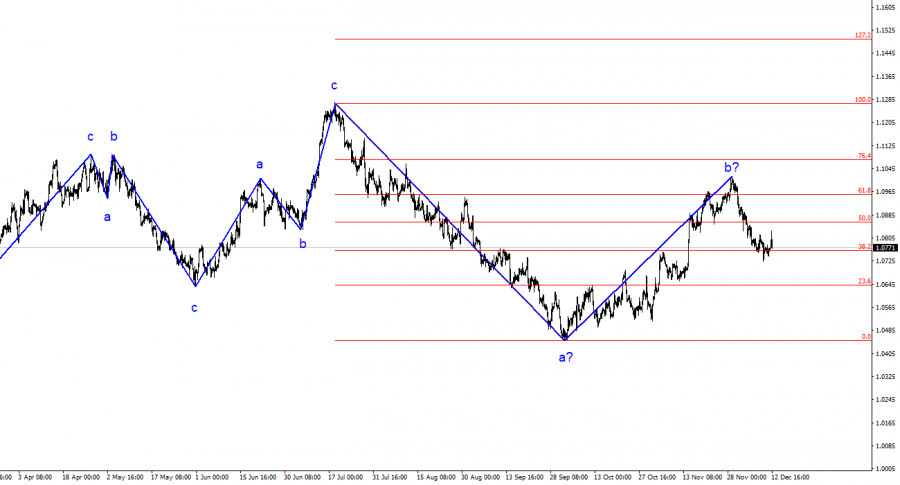

The wave analysis of the 4-hour chart for the euro/dollar pair remains quite clear. Over the past year, we have seen only three-wave structures that constantly alternate with each other. Currently, the construction of another three-wave structure, a downward one, is continuing. The presumed waves 1 and 2 are possibly completed, suggesting that the pair has moved on to the construction of the third wave, which should lead to a decrease in the pair below the 4th figure. There is a risk of complicating the assumed wave 2 or b, as the market is currently unstable and the news background can be interpreted in favor of any currency.
Nevertheless, I expect a continuation of the decline in euro quotes.
Regardless of the outcome of wave 2 or b (which may take an even more prolonged form), the overall decline of the European currency will not be completed, as the construction of the third wave of the downward trend still requires. The only option is the complication of the entire wave structure of the last months to an unrecognizable state.
The dollar is rising again. The euro/dollar pair's exchange rate increased by 20 basis points on Tuesday. Demand for the American currency slightly decreased during the day, contradicting the title of this paragraph. However, all pair movements today can be divided into "before US inflation" and "after inflation." Before the inflation report, demand for the euro currency was rising, which can be attributed to the construction of a correctional wave as part of a downward trend. Also, in the morning, optimistic economic sentiment indices (ZEW) were released in the European Union, which could increase demand for the euro. After the inflation report, demand rose for the dollar. But in the first half of the day and the second half of high market activity, we did not see any significant movements. We observed calm movements first upward, then downward, and overall, the pair's exchange rate remained almost unchanged.
Since the pair's exchange rate has not changed, no corrections can now be made to the wave analysis. The downward trend looks quite convincing, so I expect a slight deviation of quotes from the reached lows with a subsequent resumption of the decline. However, much will depend on the ECB and Fed meetings this week. If their decisions and statements support the dollar, then the first wave as part of 3 or c may take a much more prolonged form. Either way, I continue to expect a descent to the area of the 4th figure and consider this scenario viable. Therefore, we can only talk about selling the pair at the moment.

Based on the analysis conducted, I conclude that the construction of a downward wave set continues. Targets around the 1.0463 mark have been ideally worked out, and the unsuccessful attempt to break this mark indicated a transition to the construction of a corrective wave. Wave 2 or b has taken a completed form, so in the near future, I expect the construction of an impulsive descending wave 3 or c with a significant decrease in the pair. I still recommend sales with targets located below the low of wave 1 or a. At the moment, wave 2 or b can be considered complete.
On the larger wave scale, it can be seen that the construction of a corrective wave 2 or b continues, which is already more than 61.8% in length according to Fibonacci from the first wave. As I have already mentioned, this is not critical; the scenario with the construction of wave 3 or c and a decrease in the pair below the 4th figure remains valid.